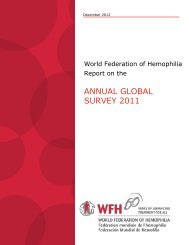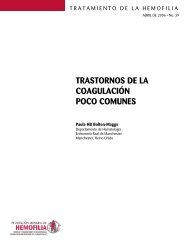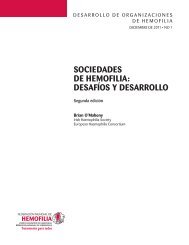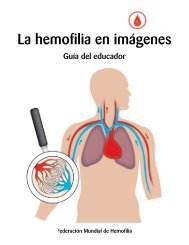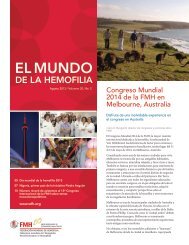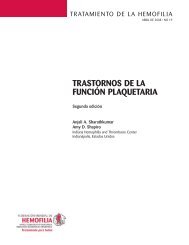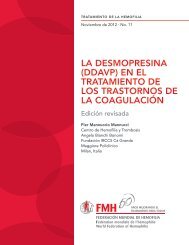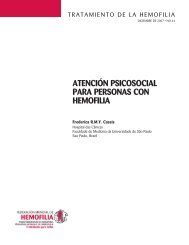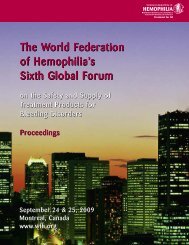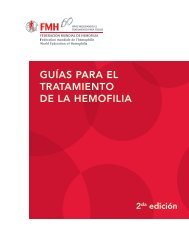Guide for the Assessment of Clotting Factor Concentrates
Guide for the Assessment of Clotting Factor Concentrates
Guide for the Assessment of Clotting Factor Concentrates
Create successful ePaper yourself
Turn your PDF publications into a flip-book with our unique Google optimized e-Paper software.
Ano<strong>the</strong>r advantage <strong>of</strong> <strong>the</strong> solvent-detergent and nan<strong>of</strong>iltration procedures is <strong>the</strong> low risk <strong>of</strong> induction<strong>of</strong> protein neoantigens.Any incidental elimination <strong>of</strong> viruses during <strong>the</strong> manufacturing procedure that contributes to <strong>the</strong>overall safety <strong>of</strong> <strong>the</strong> product should be welcomed. However, any such contributions through <strong>the</strong>manufacturing process should be viewed as supplementing ra<strong>the</strong>r than substituting <strong>for</strong> a deliberateviral elimination step.Given <strong>the</strong> repeated demonstration that enveloped viruses including HCV, HIV, and HBV are <strong>the</strong>biggest threat to <strong>the</strong> hemophilia population, authorities should focus on products with provensafety records against <strong>the</strong>se viruses through well-validated and controlled viral inactivationmechanisms.4. O<strong>the</strong>r measures to enhance safety from non-enveloped viruses, including vaccination <strong>of</strong> peoplereceiving blood products where such vaccines are available (e.g., <strong>for</strong> hepatitis A virus) anddecreasing <strong>the</strong> viral load <strong>of</strong> <strong>the</strong> plasma pool to levels not associated with infection through testing(e.g., NAT) are recommended.NAT has been shown to contribute to enhancing <strong>the</strong> safety from infection by human parvovirus B19.Manufacturers have started to incorporate such testing, and authorities may want to require NAT<strong>for</strong> specific viruses, known to be prevalent in <strong>the</strong> donor population contributing to <strong>the</strong> product. Withvalidated viral inactivation procedures <strong>for</strong> disease-causing enveloped viruses, such plasma pooltesting is probably more beneficial <strong>for</strong> unscreened non-enveloped viruses. In combination withnan<strong>of</strong>iltration, NAT may reduce <strong>the</strong> risk <strong>of</strong> small non-enveloped viruses such as B19 in <strong>the</strong> plasmapool, although this has yet to be confirmed in clinical studies.5. An assessment <strong>of</strong> efficacy is an important feature <strong>of</strong> regulatory oversight, and should be includedeven <strong>for</strong> products which are reportedly similar to o<strong>the</strong>r, better-characterized products.Some emerging countries are known to be purchasing products from manufacturers who haveacquired processes through technology transfer. These processes are <strong>the</strong>re<strong>for</strong>e intended to deliverproducts which are very similar to <strong>the</strong> products from <strong>the</strong> parent technology, which would havebeen fully characterized <strong>for</strong> physico-chemical and clinical properties. Clinical trials are expensiveand difficult with small patient populations such as hemophilia. There are <strong>the</strong>re<strong>for</strong>e understandablereservations on <strong>the</strong> part <strong>of</strong> manufacturers and authorities from <strong>the</strong>se countries to engage in <strong>the</strong>rigorous clinical trial framework mandated by <strong>the</strong> EMEA. While this framework may be modifiedaccording to <strong>the</strong> particular circumstances, it is inadvisable to abandon totally any assessment <strong>of</strong>efficacy. At <strong>the</strong> very least, an evaluation <strong>of</strong> <strong>the</strong> pharmacokinetics <strong>of</strong> <strong>the</strong> product should be per<strong>for</strong>medin order to ensure normal recovery and half life compared to historical controls. An assessment <strong>of</strong><strong>the</strong> correction <strong>of</strong> bleeding in controlled clinical circumstances should also be attempted, with asmany patients as reasonably possible. Once a country is able to resource access to products atwhatever level, <strong>the</strong>se modest measures should not be unattainable.6. Monitoring <strong>of</strong> <strong>the</strong> product’s per<strong>for</strong>mance after approval to enter <strong>the</strong> market should be per<strong>for</strong>med,in order to detect possible adverse events.The considerations outlined in point 5 <strong>for</strong> assessment <strong>of</strong> efficacy apply here as well.Given that small changes in <strong>the</strong> manufacturing process <strong>for</strong> biologicals such as hemophilia concentratescan affect in vivo in ways which are not always predictable from pre-approval assessment, itis important to monitor <strong>the</strong> product’s history in <strong>the</strong> market. Currently, <strong>the</strong> onus <strong>of</strong> concern <strong>for</strong>hemophilia products has shifted from viral safety to inhibitors. Regular monitoring <strong>of</strong> heavilyexposed patients should be a feature <strong>of</strong> hemophilia care <strong>for</strong> countries that can af<strong>for</strong>d some level <strong>of</strong><strong>Guide</strong> <strong>for</strong> <strong>the</strong> <strong>Assessment</strong> <strong>of</strong> <strong>Clotting</strong> <strong>Factor</strong> <strong>Concentrates</strong> 23



